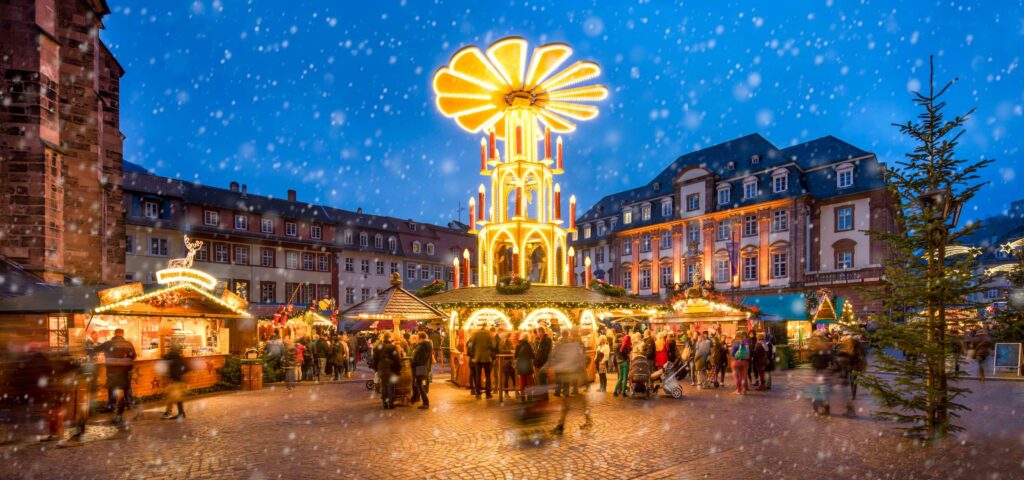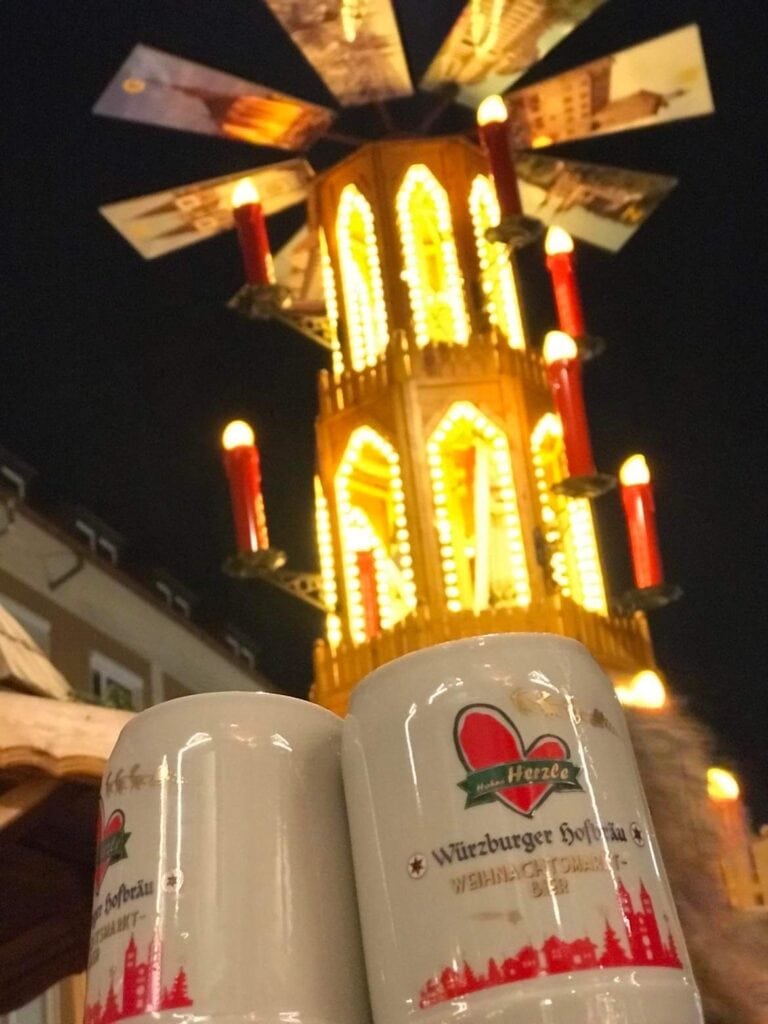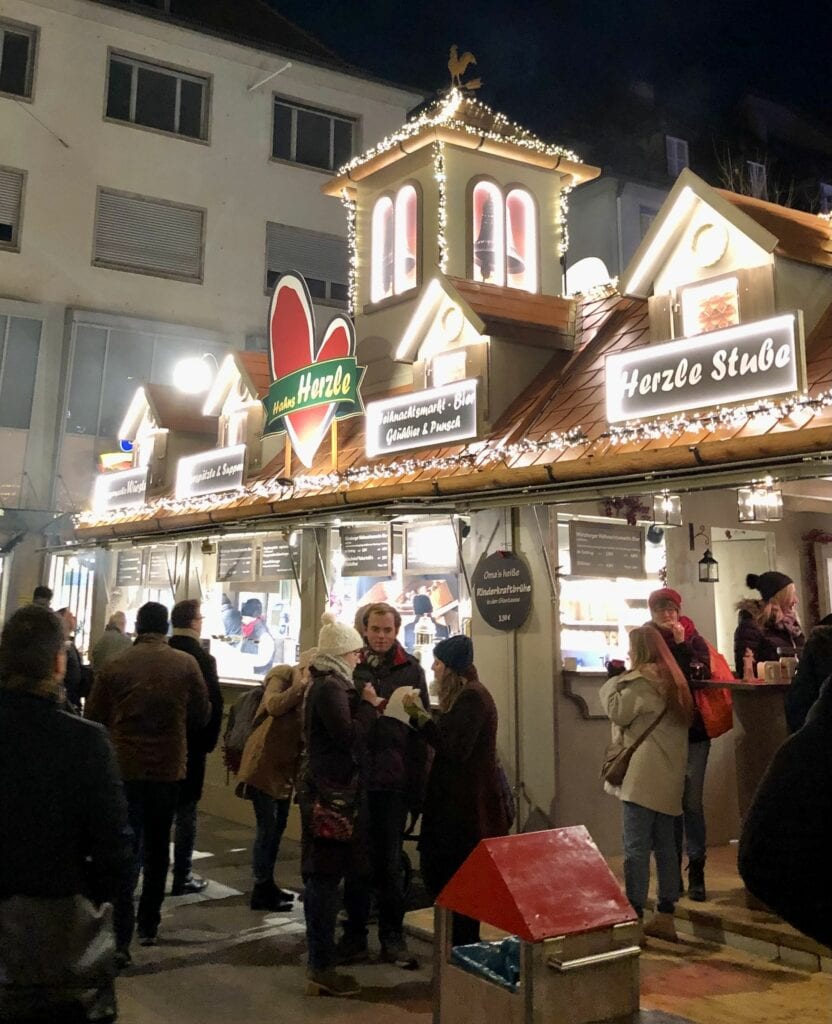Beautifully decorated wooden stalls, mulled vintner’s wine with cinnamon, gloves and oranges slices, twinkling holiday lights galore, spiced gingerbread and Plätzchen, festive carols and historic carousels: German Christmas Markets are all this and so much more. Anticipated and beloved by locals, experiencing a Weihnachtsmarkt in Deutschland, Germany is on many a bucket list.
You may’ve heard about Nuremberg’s Christkindlesmarkt or Dresden’s Stritzelmarkt. Both are known worldwide and it’s true, every German city offers at least one Christmas Market in the weeks leading up to the holidays. But. it’s in the smaller historic German heritage towns with their charming market squares, where you’ll easily become part of that true holiday magic. Here, visitors experience Christmas Markets like a local, with the locals. Stroll along beautifully decorated wooden stalls and Christmas trees, admire elaborate often hand-carved nativity scenes. Mingle with friendly residents and their friends, from lunch break to after-work and into the night — as you experience one-of-a-kind open-air markets flanked by ancient churches and cathedrals, impressive town halls, architectural masterpieces, and even castles. ‘Tis the season to eat, drink and be merry in the Historic Highlights of Germany.
The historic heritage cities of Germany have been bringing joy to the world for centuries. As always, there’s nothing like experiencing the real thing. And while the 17 Historic Highlights are at least 700 years-old, there’s always something new happening. For 2022, the long wait for the holiday season to start is over: The first festive open-air markets in our vibrant university towns have already opened their gates in late November, but December is the high season for holiday spirit made in Germany.
For a full list of dates and Christmas market events, click here.
Looking for stocking stuffers and one-of-a-kind Christmas decorations? Artisan vendors, often professional, but also crafty amateur artists offer keepsakes unique to each destination: Ornaments in every possible shape, form and material, traditional and contemporary nativity scenes, but also hand-knit sweaters, hats or shawls, artisan jewelry, and, oh the foods: Bratwurst sizzling the grills, crispy fried potato pancakes ready to be topped with apple sauce or garlic sour cream. How about a bowl of ooey gooey Käsespätzle to warm your belly and hands at the same time?



Unique Christmas Markets and Countless Festive Traditions – all made in Germany
Authentic holiday celebrations made in Germany – from the Baltic Sea to Bavaria and the Black Forest, in Germany’s heartland and also in between. All within easy reach of major airports and connected by high-speed trains. If you haven’t yet been to one or even better a few of the 17 Historic Highlights of Germany, you are missing out. Especially during holiday season.
Experiencing these unique Christmas markets and festive holiday traditions in 2022 or plan ahead for 2023: Nothing gets you into the holiday spirit faster than soaking up the smells and sounds, seeing the festive decorations and sparkling lights, then being part of these century old traditions. Seeing is believing, and it gets even more magical with a glass of Glühwein (mulled wine) or hot apple cider in hand.
Christmas Markets in the Historic Highlights at a Glance:
Twinkling Stars, the World’s largest Christmas Music Box, and oh, the Food!
(Sweet) Holiday dreams are Made of This
Gingerbread, mulled wines, a chocolate festival
- The smell of Printen fills the air in Aachen, especially this time of the year. Aachener Printen are a unique type of gingerbread, and the city’s signature sweat treat – only produced in or near the city. Fittingly, Aachen’s Christmas market even has a mascot: the “Printenmann” (Gingerbread Man). It stands almost 20 feet tall.
- Staying north, Osnabrück’s unique attraction is the largest Christmas music box in the world. Bright holiday lights illuminate the Old Town as a lovingly restored merry-go-round carousel from 1907 begs for a ride. Here, it’s St. Nikolaus opening a window each day on the huge Advent calendar in front of the Rathaus (City Hall) where Osnabrück’s treaty of the Peace of Westphalia was signed in 1648. There’s no English-speaking website for the Historischer Weihnachtsmarkt Osnabrück, but we’ll happily translate it for you.
- Six Christmas markets await you in Münster – all just minutes away from one another, in the historic heart of town that’s centered around Prinzipalmarkt.
- Twinkling stars all over town give Wiesbaden’s Christmas market its special English name. In German, the event’s known as “Sternschnuppenmarkt”, and the setting is star-worthy indeed. The Twinkling Star Christmas Market takes place on idyllic Schlossplatz (Palace Square) and alongside the historic city palace and casino. Holiday concerts, ice skating, carolers, nativity plays and fairy tales add to a one-of-a-kind ambiance. Not to be missed and a new addition, is the Kindersternschnuppenmarkt with even more offerings for the young and young at heart. The highlight: A kids’ bakery where girls and boys learn how to make traditional Butterplätzchen (German Christmas cookies) and even get to take them home.
- Short, but mighty sweet is the Tübinger Weihnachtsmarkt, held on just one weekend: December 9 through 11, 2022. Following the city’s annual chocolate festival, an impressive 350 stands await visitors – and the offerings include mostly homemade treats and crafts by local community and charitable organizations, making this holiday event truly one-of-a-kind and a Christmas Market not to be missed.
- Let’s stay in the southwest, and head to Freiburg. Despite its perfect location in the Black Forest region, the Christmas Market here is rather new, but full of traditional features: From glass-blowing demonstrations to typical Swabian eats including chestnuts roasting on an open fire. Take a look at the “Top 10 Things to do” at Freiburger Weinachtsmarkt. There’s even a workshop to make candles. For great views of the market and surrounding Black Forest area, take a ride on the extra tall ferris wheel.
Christmas Celebrations along Germany’s rivers
Not just wurst, but also beer and even vegan treats
- Bonn celebrates Christmas with the city’s native son Beethoven. The composer’s Memorial on Münsterplatz overlooks the entire event. A ride on the historic ferris wheel brings you to eye level with Beethoven’s statue. Stroll through the alleys to the right and left of Münsterplatz to discover the entire enchanting Christmas market.
- Continuing south, Koblenz’, known as the “Gateway to the Romantic Rhine”, offers a traditional Christmas fair throughout the historic Altstadt (Old Town). Koblenzer Weihnachtsmarkt is the only of its kind with a privileged location on two very important rivers: The Rhine and Moselle.
- Speaking of the river Moselle, in Germany´s oldest city, Trier, you’ll witness glorious history every step of the way. Stroll through the bustling Old Quarter to Hauptmarkt and Dom. The main market and ancient cathedral are the picturesque backdrop for the Trierer Weihnachtsmarkt. Winzer-Glühwein, local vintner’s mulled wine, is a must-try here as in other wine growing heritage towns. Red, white or rosé?
- Wine is also a must-try in Würzburg, year-round, and even served at the annual almost 1,000 year-old beer festival, but that’s another story. Located on the Main river, in the Franconia region of Bavaria, Würzburg is the northern gateway to the Romantic Road. Starting on 11/23 and on for four weeks, you’ll be greeted by welcoming locals at the Würzburger Weihnachtsmarkt – a beloved local celebration on the farmer’s market square with “a long tradition and lots of holiday cheer”. New in 2022 is the “ Kleine Weihnachtsmetzgerei” at Hahns’ Herzele: A miniature version of a traditional working German butcher shop, with a holiday twist. But it’s not all about the wurst. In Würzburg, like in every Historic Highlight, a special emphasis is placed on offering local, seasonal cuisine. And farm to table in Germany also means vegetarian, vegan and gluten-free options. Prost & Guten Appetit. P.S. You’ll also get a locally brewed beer here, even at the Weihnachtsmarkt (and it’s cold!).
- Heidelberg on the Neckar is renowned for its romantic, fairytale atmosphere of times past that come even more alive when the magic of Christmas illuminates the Old Town. In addition to the Heidelberger Weihnachtsmarkt, the quintessential winter experience here is “Christmas on Ice”: Ice-skating in an open-air rink at the foot of the world-famous castle. Instead of offering just one main market, in Heidelberg, the wooden stalls, attractions and tasty temptations stretch throughout town.
- Last, but not least, let’s take you to Regensburg on the Danube, also known as the Christmas-market capital. Regensburger Christkindlmarkt is internationally acclaimed as one of the best and most popular Christmas markets anywhere, with its impressive setting in the heart of a UNESCO World Heritage Site. Already mentioned in 1791, traditions are kept alive and you’ll be transported back in time and experience Bavarian Christmas at its best.
Holiday Travels Back in Time, with a Modern Twist
Ancient crafts, Christmas Angels, a literary tribute and Santa’s secret ride
- Augsburg in Bavaria, Germany is home to one of the country’s oldest Christmas Markets, dating back to the 15th century. Originally just locally produced ginger bread was traded. This delicious sweet signature treat is still a must-try today – and you’ll be in awe of how many different variations there are. Known as the “Augsburger Christkindlesmarkt”, the lovingly decorated booths and attractions form a village within the historic city center – with offerings for visitors of all ages. Unique to Augsburg is the “Engelesspiel” (Angel Performance). Every Friday, Saturday and Sunday at 6pm, plus on December 23rd, twenty-three local girls, dressed as angels, appear on the beautiful facade of City Hall to transform the building into a huge Advent calendar. “A charming facial expression, graceful movements, and musical talent are required to become an Augsburg Angel”. Experiencing this unique tradition in person is highly recommended: ideally with a glass of Glühwein (mulled wine) in hand.
- Continuing in the heart of the country, Erfurt´s historic Old Town with its twin cathedral creates a magical setting for the Christmas market with a tradition of more than 150 years. Craftsmen sell a wide range of original Thuringian handicrafts at Erfurt’s Christmas Fair from tree decorations to blue print textiles and a wide selection of ceramics and pottery.
- Next is Potsdam with Christmas markets in the historical Old Town near “Schloss Sanssouci” (Sanssouci Palace) – lit by blue lights giving the main market its special name: Blauer Lichterglanz. In Potsdam’s famous Dutch Quarter, the “Sintaklaas” Christmas market pays homage to tradition from the namesake Netherlands, including culinary delights from Holland.
- To bring you full circle on this holiday journey across and around historic Germany, the largest Christmas market in the north of the country, Rostocker Weihnachtsmarkt originated in the middle ages already. Today, a festive blaze of lights showcases venerable merchant houses, brick gables and churches – the stony witnesses of Rostock as a Hanseatic city. What sets Rostock apart is a modern twist on the ‘arrival’ of Santa Claus. To kick off the festivities, the jolly old guy makes a special appearance at the opening event – with his ride being a well kept secret every year. Any guesses what it’ll be in 2022? We’ll find out on 11/21/22.
- As Thomas Mann, winner of the Nobel Prize for Literature, and a native son of Lübeck, once said: “I will never lose my love for the magic of Christmas”. First mentioned in 1648, Christmas markets have a long tradition in the Hanseatic town of Lübeck, located like Rostock, on the Baltic Sea. In accordance, traditional craftsmen offer their products from way back when, inside the church of St. Petri. Known as “the Christmas City of Germany’s North”, with eleven market experiences, Lübeck invites you to stroll through the many winding streets of the Old Town and to enjoy the Christmas markets on the various squares.
To summarize: Christmas Markets are just one example of a myriad of century old holiday traditions that date back centuries and are as diverse as the cities celebrating them. We’ll cordially invite you to experience the Historic Highlights of Germany year-round, but especially at this most beautiful time of the year.
